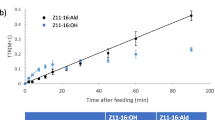Abstract
The half-lives (t 1/2) of alcohol sex pheromones, 1-alkanols, acetate sex pheromones, and an epoxide (disparlure) were determined on natural rubber septa. Thet 1/2 values for the homologous alcohols from decanol to heptadecanol increased regularly from 2.2 to 1117 days, but thet 1/2 of octadecanol was 609 days. Thet 1/2 values of (Z)7-, (E)7-, and (Z)9-tetradecen-1-ol acetates were 154, 168, and 199 days, respectively, whereas those of five other tested 14-carbon acetates ranged from 310 to 350 days. The dependence oft 1/2 values on chain length and double-bond position is consistent with the hypothesis that molecular size is an important variable affectingt 1/2 values. Also, in accordance with the hypothesis, when aZ-alkenyl compound has a much shortert 1/2 than the corresponding saturated compound, thet 1/2 values of theZ compound and itsE isomer may be quite different. Thus, (E)-9-tetradecen-l-ol acetate had at 1/2 of 331 days. Thet 1/2 of disparlure was 180 days. The effect of thecis-7,8 epoxide group is apparently similar to that of the olefin group in lowering thet 1/2 below the value that would be expected solely on the basis of chain length.
Similar content being viewed by others
References
Bierl, B.A., Beroza, M., andCollier, C.W. 1970. Potent sex attractant of the gypsy moth: Its isolation, identification, and synthesis.Science 170:87–89.
Butler, L.I., andMcDonough, L.M. 1979. Insect sex pheromones: Evaporation rates of acetates from natural rubber septa.J. Chem. Ecol. 5:825–837.
Daterman, G.E. 1974. Synthetic sex pheromone for detection survey of European pine shoot moth.USDA Forest Service Research Paper PNW-180.
Davis, H.G., Eves, J.D., andMcDonough, L.M. 1979. Trap and synthetic lure for the checkered flower beetle, a serious predator of leafcutting bees.Environ. Entomol. 8:147–149.
Lloyd, J.E., andMathysse, J.G., 1966. Polymer-insecticide systems for use as livestock feed additives.J. Econ. Entomol. 59:363–367.
Maitlen, J.C., McDonough, L.M., Moffitt, H.R., andGeorge, D.A. 1976. Codling moth sex pheromone: Baits for mass trapping and population survey.Environ. Entomol. 5:199–202.
McDonough, L.M. 1978. Insect sex pheromones: Importance and determination of half-life in evaluating formulations.USDA, SEA, ARR-W-1.
Sharma, R.K., Shorey, H.H., andGaston, L.K. 1971. Sex pheromones of noctuid moths. XXIV. Evaluation of pheromone traps for males ofTrichoplusia ni.J. Econ. Entomol. 64:361–364.
Author information
Authors and Affiliations
Additional information
This paper reports the results of research only. Mention of a commercial product in this paper does not constitute a recommendation by the U.S. Department of Agriculture.
Rights and permissions
About this article
Cite this article
Butler, L.I., McDonough, L.M. Insect sex pheromones: Evaporation rates of alcohols and acetates from natural rubber septa. J Chem Ecol 7, 627–633 (1981). https://doi.org/10.1007/BF00987710
Received:
Revised:
Issue Date:
DOI: https://doi.org/10.1007/BF00987710




